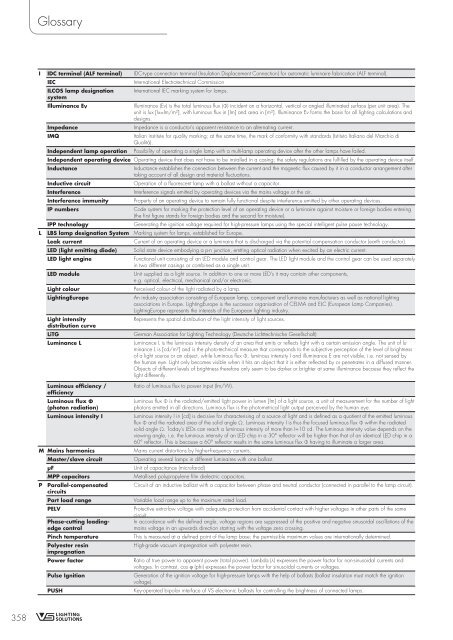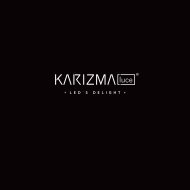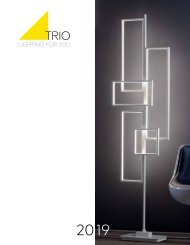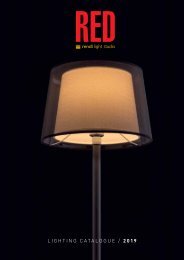VS_2017
Create successful ePaper yourself
Turn your PDF publications into a flip-book with our unique Google optimized e-Paper software.
Glossary<br />
I IDC terminal (ALF terminal) IDC-type connection terminal (Insulation Displacement Connection) for automatic luminaire fabrication (ALF terminal).<br />
IEC<br />
International Electrotechnical Commission<br />
ILCOS lamp designation International IEC marking system for lamps.<br />
system<br />
Illuminance E V<br />
Illuminance (Ev) is the total luminous flux (Φ) incident on a horizontal, vertical or angled illuminated surface (per unit area). The<br />
unit is lux [lx=lm/m²], with luminous flux in [lm] and area in [m²]. Illuminance Ev forms the basis for all lighting calculations and<br />
designs.<br />
Impedance<br />
Impedance is a conductor's apparent resistance to an alternating current.<br />
IMQ<br />
Italian institute for quality marking; at the same time, the mark of conformity with standards (Istituto Italiano del Marchio di<br />
Qualitá).<br />
Independent lamp operation Possibility of operating a single lamp with a multi-lamp operating device after the other lamps have failed.<br />
Independent operating device Operating device that does not have to be installed in a casing; the safety regulations are fulfilled by the operating device itself.<br />
Inductance<br />
Inductance establishes the connection between the current and the magnetic flux caused by it in a conductor arrangement after<br />
taking account of all design and material fluctuations.<br />
Inductive circuit<br />
Operation of a fluorescent lamp with a ballast without a capacitor.<br />
Interference<br />
Interference signals emitted by operating devices via the mains voltage or the air.<br />
Interference immunity Property of an operating device to remain fully functional despite interference emitted by other operating devices.<br />
IP numbers<br />
Code system for marking the protection level of an operating device or a luminaire against moisture or foreign bodies entering<br />
(the first figure stands for foreign bodies and the second for moisture).<br />
IPP technology<br />
Generating the ignition voltage required for high-pressure lamps using the special intelligent pulse pause technology.<br />
L LBS lamp designation System Marking system for lamps, established for Europe.<br />
Leak current<br />
Current of an operating device or a luminaire that is discharged via the potential compensation conductor (earth conductor).<br />
LED (light emitting diode) Solid state device embodying a p-n junction, emtting optical radiation when excited by an electric current.<br />
LED light engine<br />
Functional unit consisting of an LED module and control gear. The LED light module and the control gear can be used separately<br />
in two different casings or combined as a single unit.<br />
LED module<br />
Unit supplied as a light source. In addition to one or more LED's it may contain other components,<br />
e.g. optical, electrical, mechanical and/or electronic.<br />
Light colour<br />
Perceived colour of the light radiated by a lamp.<br />
LightingEurope<br />
An industry association consisting of European lamp, component and luminaire manufacturers as well as national lighting<br />
associations in Europe. LightingEurope is the successor organisation of CELMA and ELC (European Lamp Companies).<br />
LightingEurope represents the interests of the European lighting industry.<br />
Light intensity<br />
Represents the spatial distribution of the light intensity of light sources.<br />
distribution curve<br />
LiTG<br />
German Association for Lighting Technology (Deutsche Lichttechnische Gesellschaft)<br />
Luminance L<br />
Luminance L is the luminous intensity density of an area that emits or reflects light with a certain emission angle. The unit of luminance<br />
L is [cd/m²] and is the photo-technical measure that corresponds to the subjective perception of the level of brightness<br />
of a light source or an object, while luminous flux Φ, luminous intensity I and illuminance E are not visible, i.e. not sensed by<br />
the human eye. Light only becomes visible when it hits an object that it is either reflected by or penetrates in a diffused manner.<br />
Objects of different levels of brightness therefore only seem to be darker or brighter at same illuminance because they reflect the<br />
light differently.<br />
Luminous efficiency /<br />
efficiency<br />
Ratio of luminous flux to power input (lm/W).<br />
Luminous flux Φ<br />
(photon radiation)<br />
Luminous intensity I<br />
Luminous flux Φ is the radiated/emitted light power in lumen [lm] of a light source, a unit of measurement for the number of light<br />
photons emitted in all directions. Luminous flux is the photometrical light output perceived by the human eye.<br />
Luminous intensity I in [cd] is decisive for characterising of a source of light and is defined as a quotient of the emitted luminous<br />
flux Φ and the radiated area of the solid angle Ω. Luminous intensity I is thus the focused luminous flux Φ within the radiated<br />
solid angle Ω. Today's LEDs can reach a luminous intensity of more than I=10 cd. The luminous intensity value depends on the<br />
viewing angle, i.e. the luminous intensity of an LED chip in a 30° reflector will be higher than that of an identical LED chip in a<br />
60° reflector. This is because a 60° reflector results in the same luminous flux Φ having to illuminate a larger area.<br />
M Mains harmonics<br />
Mains current distortions by higher-frequency currents.<br />
Master/slave circuit<br />
Operating several lamps in different luminaires with one ballast.<br />
µF Unit of capacitance (microfarad)<br />
MPP capacitors<br />
Metallised polypropylene film dielectric capacitors.<br />
P Parallel-compensated Circuit of an inductive ballast with a capacitor between phase and neutral conductor (connected in parallel to the lamp circuit).<br />
circuits<br />
Part load range<br />
Variable load range up to the maximum rated load.<br />
PELV<br />
Protective extra-low voltage with adequate protection from accidental contact with higher voltages in other parts of the same<br />
circuit.<br />
Phase-cutting leadingedge<br />
control<br />
In accordance with the defined angle, voltage regions are suppressed of the positive and negative sinusoidal oscillations of the<br />
mains voltage in an upwards direction starting with the voltage zero crossing.<br />
Pinch temperature<br />
This is measured at a defined point of the lamp base; the permissible maximum values are internationally determined.<br />
Polyester resin<br />
impregnation<br />
High-grade vacuum impregnation with polyester resin.<br />
Power factor<br />
Pulse Ignition<br />
PUSH<br />
Ratio of true power to apparent power (total power). Lambda (λ) expresses the power factor for non-sinusoidal currents and<br />
voltages. In contrast, cos (phi) expresses the power factor for sinusoidal currents or voltages.<br />
Generation of the ignition voltage for high-pressure lamps with the help of ballasts (ballast insulation must match the ignition<br />
voltage).<br />
Key-operated bipolar interface of <strong>VS</strong> electronic ballasts for controlling the brightness of connected lamps.<br />
358

















